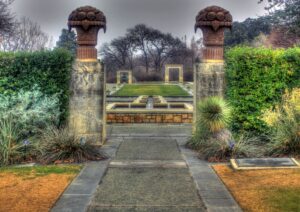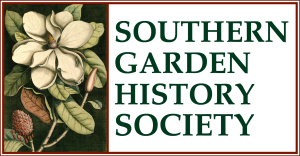
The Southern Garden History Society has so far missed out on an annual meeting visit to the Dallas Arboretum and Botanical Garden (DABG) and its expansive array of spiraling pathways and named garden rooms. When a Dallas meeting does occur it will surely be on our agenda.*
Spanning sixty-six acres on the shore of White Rock Lake, DABG dates only to 1984, thus being two years younger than SGHS. Yet, its history as a designed landscape begins in 1938 when oil-wealthy geophysicist Everette DeGolyer and his wife Nell Goodrich DeGolyer began construction of a massive home. After acquiring a forty-three-acre former dairy farm site, the DeGolyers turned to California architects Denman Scott and Burton Shutt for a Spanish Colonial Revival design that best suited their fondness for Mexican and Southwestern United States life and culture, naming the overall property Rancho Encinal.
As with many other sites discussed on the Gardens page, they engaged a Harvard-trained landscape architect to develop plans that embraced the lake side setting and complemented the work of Scott and Shutt. Receiving the commission was Arthur Shoene Berger, a Kansas native and University of Kansas botany graduate who in 1928 had received a landscape architecture degree from Harvard.** Berger’s professional development included a five-year association with the New York office of Italian-born landscape architect Feruccio Vitale. Later creating his own firm in Ohio, Berger spent his winters in Dallas, a situation that led to the coveted DeGolyer commission. (Subsequently, Arthur Berger would begin partnering with landscape architect Marie Harbeck, the couple marrying in 1946 and jointly completing many successful projects in the region and further afield.)
Sources cited below note that Berger worked closely with the architects, along with Nell DeGolyer, regarding landscape installations to ensure optimal coordination between views from the house and viewscapes. So successful was Berger’s Rancho Encinal efforts, that various elements of his work remain at DABG, including the magnolia allée, octagonal fountain, wisteria arbor, rose garden, and sunken garden.
The DeGolyer site national register nomination notes the family had hoped their estate could become a “study center, ” comparable to Dumbarton Oaks.*** Fortune dictated, however, that much of their fine and extensive library would be moved to the SMU campus, while the property went on to be purchased by the City of Dallas, ultimately becoming the core of DABG. Subsequently, the grounds would be expanded by further land acquisition resulting in the DABG sixty-six-acre park. Today it offers nothing if not a variety of landscape experiences in distinct rooms including myriad types of statuary, pools and falling-water features, serpentine paths, and stone hardscape elements that complement grass panels, formally arranged and carefully pruned formal gardens, and innumerable bulbs, annuals, and herbaceous plants. Living up to its name, DABG also encompasses a wide variety of specimen trees spanning the park.
A later addition but a signature feature here is A Woman’s Garden, installed in two phases in 1997 and 2006 and designed by another Harvard-trained, and in this case Massachusetts-based, landscape architect, Morgan Dix Wheelock. His work, underwritten and endowed by the Women’s Council of DABG, gains much of its westerly side character from symmetrical water features in the form of a fountain set near the DeGolyer House, its water flowing eastward via a terraced waterfall leading to a series of rigidly rectangular pools. The entire garden, moreover, is near the lake shore with attendant water views. The easterly side of the Woman’s Garden breaks with symmetry in its curving pathways but still leans heavily on water via a meandering stream and the acequia fountain and falls. Other distinct spaces within the overall Woman’s Garden space include a poetry garden and a zone termed “orchid hollow.”
DABG also gets high marks for awareness of the farm-to-table movement and thus introducing the innovative garden, A Tasteful Place. This 3.5-acre area site features a potager combining fruit, vegetables, flowers, and herbs, accompanied by a kitchen and pavilion. Created to be visitor interactive, the year-round garden offers daily tastings and introduces guests not only to foodstuffs that can be grown at home but also to methods for preparation and cooking.
There is, of course, far more to see here when the Society is ultimately able to arrange a Dallas meeting. Given the SGHS typical spring meeting dates, we will surely be too early to get a tomato from A Tasteful Place, but the strawberries should be really nice.
************************************************************
*https://www.dallasarboretum.org/
**For more on Berger and his landscape architect wife, Marie, see: https://www.tshaonline.org/handbook/entries/berger-arthur-shoene
***The National Register nomination includes an excellent discussion of Rancho Encinal’s history: https://dallascityhall.com/departments/sustainabledevelopment/historicpreservation/HP%20Documents/Landmark%20Structures/DeGolyerEstate%20National%20Register.pdf
****For more on Wheelock see: https://h1960.classes.harvard.edu/article.html?aid=576
See also: https://www.tclf.org/landscapes/dallas-arboretum-and-botanical-garden

Leave a Reply